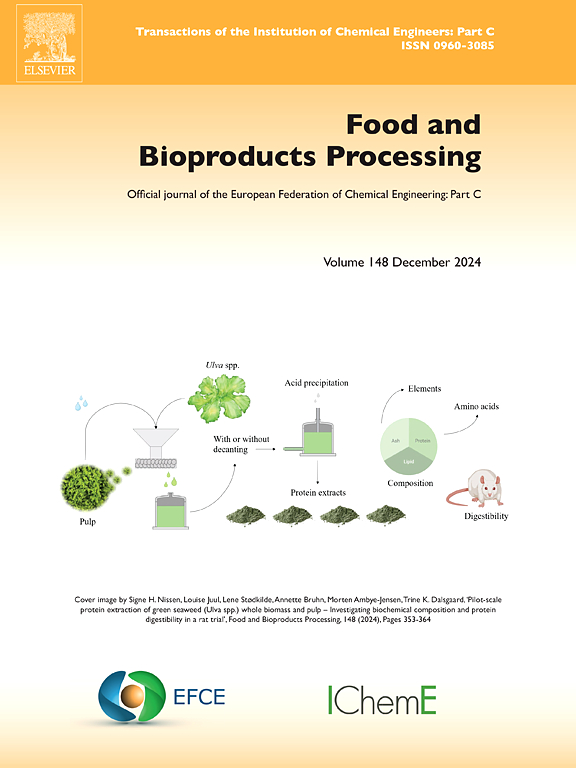Comprehensive analysis of critical nutrient factors influencing the tropism of Nannochloropsis sp. for eicosapentaenoic acid-rich lipid production
IF 3.5
2区 农林科学
Q2 BIOTECHNOLOGY & APPLIED MICROBIOLOGY
引用次数: 0
Abstract
Nannochloropsis species are esteemed for their capacity to produce lipids rich in eicosapentaenoic acid (EPA), crucial for various industrial applications. However, elucidating the precise influence of critical nutrient factors on Nannochloropsis tropism poses challenges due to species-specific variations. This study aims to unravel the kinetic behavior of Nannochloropsis sp. CCAP 211/78 under varied critical nutrient concentrations and their combinatorial effects in both phototrophic and mixotrophic cultivation modes to enhance EPA-rich lipid production. The kinetic parameters for lipid production were maximized under optimal cultivation conditions of 45 g/L salinity, an N/P ratio of 25:1, and a nitrate concentration of 75 mg/L. Mixotrophic cultivation at 20 g/L glucose induced maximum lipid accumulation due to oxidative stress, achieving lipid contents of 20.76 ± 0.26 % and 51.92 ± 0.36 % dry biomass in the early and late stationary phases, respectively. Combinatorial analysis of the optimized nutrients in phototrophic (OP) and mixotrophic (OM) modes of cultivation demonstrated synergy in enhancing overall lipid productivity. OP mode exhibited biomass productivity, lipid and EPA content of 166.71 ± 4.82 mg L−1 d−1, 28.36 ± 0.89 % and 60.32 ± 6.35 mg g−1 dry biomass, respectively, compared to 116.69 ± 2.24 mg L−1 d−1, 39.23 ± 1.45 % and 81.73 ± 8.38 mg g−1 dry biomass, respectively, in OM mode. This research contributes to a comprehensive understanding of the interplay between critical nutrients and Nannochloropsis tropism, providing valuable insights for optimizing EPA-rich lipid production at different biorefinery scenarios.
影响纳米绿藻对富含二十碳五烯酸的脂质产生趋向性的关键营养因素的综合分析
纳米绿藻物种因其生产富含二十碳五烯酸(EPA)的脂质的能力而受到尊重,这对各种工业应用至关重要。然而,由于物种特异性的差异,阐明关键营养因子对纳米叶绿体嗜性的确切影响存在挑战。本研究旨在揭示纳米叶绿素CCAP 211/78在不同临界营养浓度下的动力学行为,以及它们在光养和混养培养模式下的组合效应,以促进富含epa的脂质产生。在盐度为45 g/L、氮磷比为25:1、硝酸盐浓度为75 mg/L的最佳培养条件下,产脂动力学参数最大。葡萄糖浓度为20 g/L的混合营养培养诱导了氧化应激引起的最大脂质积累,固定前期和固定后期干生物量脂质含量分别为20.76 ± 0.26 %和51.92 ± 0.36 %。光养(OP)和混合营养(OM)培养模式下优化的营养成分组合分析表明,在提高整体脂质生产力方面具有协同作用。OP模式表现出生物生产力、脂质和EPA含量166.71 ±4.82 mg L−1 d−1, 28.36±0.89 %和60.32±6.35 毫克 克−1干重分别比 116.69±2.24 mg L−1 d−1, 39.23±1.45 %和81.73±8.38 毫克 克−1干生物量,分别在OM模式。这项研究有助于全面了解关键营养物质与纳米叶绿体向性之间的相互作用,为优化不同生物炼制方案下富含epa的脂质生产提供有价值的见解。
本文章由计算机程序翻译,如有差异,请以英文原文为准。
求助全文
约1分钟内获得全文
求助全文
来源期刊

Food and Bioproducts Processing
工程技术-工程:化工
CiteScore
9.70
自引率
4.30%
发文量
115
审稿时长
24 days
期刊介绍:
Official Journal of the European Federation of Chemical Engineering:
Part C
FBP aims to be the principal international journal for publication of high quality, original papers in the branches of engineering and science dedicated to the safe processing of biological products. It is the only journal to exploit the synergy between biotechnology, bioprocessing and food engineering.
Papers showing how research results can be used in engineering design, and accounts of experimental or theoretical research work bringing new perspectives to established principles, highlighting unsolved problems or indicating directions for future research, are particularly welcome. Contributions that deal with new developments in equipment or processes and that can be given quantitative expression are encouraged. The journal is especially interested in papers that extend the boundaries of food and bioproducts processing.
The journal has a strong emphasis on the interface between engineering and food or bioproducts. Papers that are not likely to be published are those:
• Primarily concerned with food formulation
• That use experimental design techniques to obtain response surfaces but gain little insight from them
• That are empirical and ignore established mechanistic models, e.g., empirical drying curves
• That are primarily concerned about sensory evaluation and colour
• Concern the extraction, encapsulation and/or antioxidant activity of a specific biological material without providing insight that could be applied to a similar but different material,
• Containing only chemical analyses of biological materials.
 求助内容:
求助内容: 应助结果提醒方式:
应助结果提醒方式:


